Stage three of the NC is the under 10 and 11 year age groups. These age groups fall into the skill acquisition phase or the golden age. This is an ideal time to increase the technical and insight components of T.I.C acronym mentioned previously. Players are being prepared technical and tactically to enter the full field a year later (U12).
Age Group Characteristics
The players have just gone through a large growth phase and have quite good motor skills. Players who are born in the early part of the year will generally be taller and more powerful. Do not neglect the smaller skilled players. Six months of age difference can reflect in a large way on the physical characteristics of the players and thus their opportunity for selection in elite sports at an early age. An excellent review on sporting success can be found in the book "Outliers" (1). Due to this age difference there may also be a difference in the cognitive ability of the players. Coaches need to consider this when selecting and developing players. In my son's age group (U15) this has proven to be true. Smaller less developed players at 10, 11 and 12 have matured into quite skilled and athletic players who now outshine many players who were more physically developed at 10-12 years.
Players at this age also have a better understanding of teamwork, and their role in the team.
Training Content
Content should include more strict correction of technique, ie passing and receiving, running with the ball, 1v1, heading, first touch goal keeping and heading. Continue teaching football turns, fakes and feints as well. This is also a good age group to coach defence and tackling techniques. More highly skilled players should already be in FFA approved academies who are working with skill acquisition trainers. They will still be allowed and encouraged to play community football. If coaches have these players in their teams please discuss aims and training focus with academy coaches to improve outcomes for both parties.
Concepts of attack, defence and transition should be developed as well as the player's positions and roles. Within these tactical concepts, the ideas of space need to be highlighted. Continue to rotate player's positions regularly.
Team Shape and Roles
The field expands to half a field with 9v9 including goalkeepers. Attacking shape becomes a 1-3-2-3 (see figure1). Defensive shape can vary but the easiest formation is to drop the wing forwards back to a 3-4-1 or 4-4. The 1-3-2-3 shape has strong links to the full field 11v11, 1-4-3-3 shape. There is strong triangulation created by field positions, which include a back three, two central midfielders and a front three. The problem of defending wide areas becomes evident, as we have included another line of players, positioned centrally.
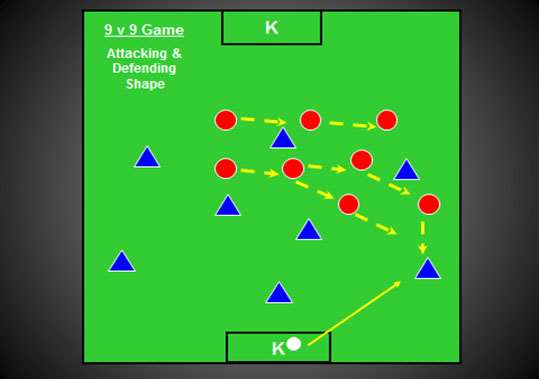
Figure 1.
Please read my previous blog (U8/9) on roles and positions for the 1-3-3 shape. The 1-3-2-3 shape is similar except we now have larger distances between lines in wide areas. List how you would defend these wide areas and what the player's roles are (defenders, midfield and forwards)?
The central midfielders have roles in defence and attack:
- In attack, one midfielder may push forward. During this phase the other midfielder must maintain a staggered position for support and to respond to a counter attack. Remember, getting beaten centrally will quickly cause the formation to fail (just as in the 1-4-3-3)
- During attack, one midfielder may take on the role of a number 10 supporting the central attacker.
- The midfielders act to distribute the ball. Centrally and wide.
- In defence, the midfielders recover and may drop into the defensive line, depending on how the coach wishes to play the team, or as the situation requires.
Take over roles can start to be coached during these age groups. This may mean overlapping of wingbacks, pushing a central defender into the midfield with coverage from a wide defender, or changing the central attacker and midfielder.
Use a basic walk through to get the basic shapes and concepts across to the team. Do this regularly for 5 minutes every second session or so. Perhaps this could be done at the end of sessions.
Sample Session - Attacking from the Back for 11 year olds
This session is designed for 12 more advanced 11 year olds and includes all the components of a modern coaching session based around game sense training. Whilst appearing to be a more advanced topic attacking from the back is a basic concept of possession.
Warm-up
Personally, I like to do technique training at the start of the session, with some fun games to start to vary the sessions. This could involve tag, handball/head ball, etc. Figure 2 shows a general passing technique exercise that will be built up in complexity as players get older. The next progression is a "bounce pass" back to the passer (1). The player then makes a run off the ball around his cone into the path of the ball. Ensure players "check in" to receive the ball and receive with the furthest foot. Coach first touch and movement as well. Players follow their pass. Once players return to where they began they cross to the other side so that both feet are used to pass and receive.
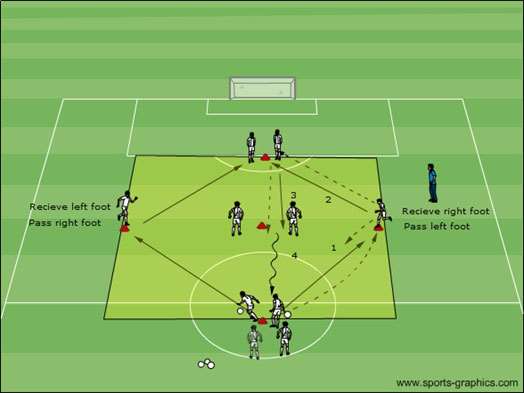
Figure 2. Passing and Receiving
Basic Positional Games
These games should be done regularly to improve insight and decision making (the" I" in TIC). These games can become quite complex later on (please refer to the references in previous blogs for new ideas on positional games). Keep them basic in this age group. This includes 3v1, 4v1, 4v2, 5v2 and 5v3 with boundaries. Make the areas bigger or smaller depending on the ability of the players.
Coaching points should include passing and receiving technique, opening body out and avoiding playing into corners, and moving and preparing to receive a pass. The 4v2 and 5v2/3 positional games are a possession game. Start these games with attackers on the outside of the rectangle and moving along the sides. As players improve, allow all players to play inside the area, limit touches and the size of the field. The additional feature of these basic games is that they are teaching 1st, 2nd, 3rd and 4th passing options. Give the defenders tasks to force mistakes. If they win the ball, they can attempt to dribble to the outside of the square for a point and the attackers attempt to stop them.
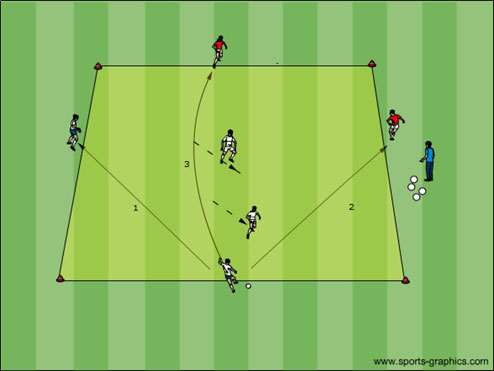
Figure 3. 4v2
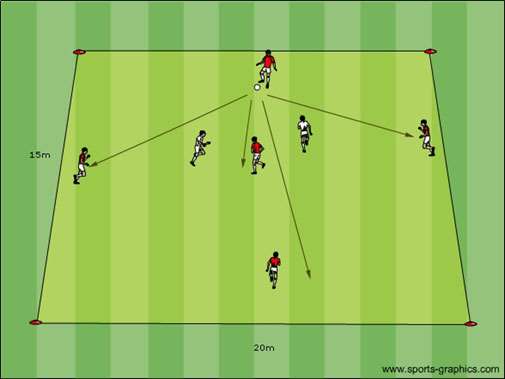
Figure 4. 5v2
Main Part
Figure 4 shows a basic transition style game with 8 players. This type of game can be expanding upon in the older age groups with more players and a central zone for midfielders. In this way the ball must be played through the midfield.
The ball is played out in one half (2v1). The ball is passed or dribbled into the next half, allowing another attacker into the half, where another 2v1 situation takes place. Players and goal keepers rotate continually to create 2v1 situation in each half. Make a point of coaching width in attack, passing and receiving, and movement off the ball (attacker in next half getting "free").
As players progress, additional restrictions can be placed on the players before an extra player can enter the next zone, eg, a "bounce pass"
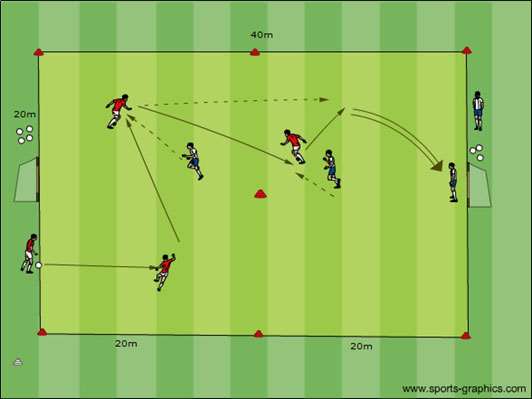
Figure 5. 3v3 Attacking from the back
Final Part
A 5v5 + 1 + goalkeeper game can be played to correct and re-enforce the concepts introduced in the main part of the session (figure 5). The game always starts with the goal keeper playing out. Teams in attack should play in a 3-2 or 2-1-2 (same as 5v2 positional game) formation with the central player also performing the duties of a central defender. Place the extra player as a target player at one end of the field and or use two small goals to simulate passing to a forward. To help the team play out don't allow attackers into the other half until the goalkeeper has release the ball. As players improve remove this rule. The game can be progressed by encouraging teams to transition after a goal is scored.
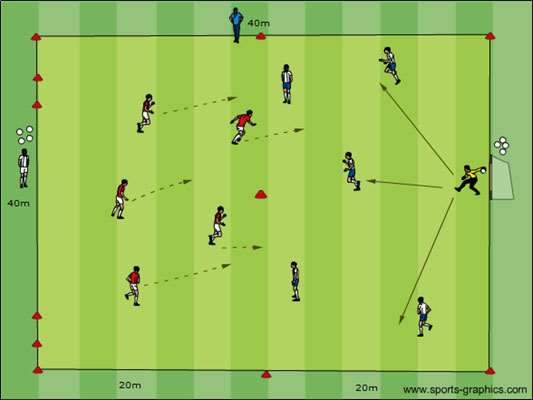
Figure 6. 5v5+1+Goalkeeper
Another option, is a progression of the 3v3 game for advancing players (figure 7). This game is detailed in the senior licence notes. The field is extended and players play out using the goal keeper with 3v2 in one half and 2v2 in the other half. The attacking team can pass or dribble into the other half then push another player into the half to create another 3v2 overload situation.
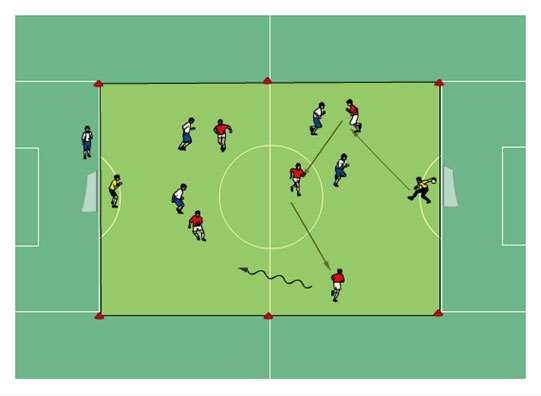
Figure 7. 5v5 Attacking from the back
Conclusion
The 3-2-3 formation used in the U10/11 age groups and the 3-1-3 can be used in formation training with older age groups who play 1-4-3-3, as a SSG, function or a phase of play. The central midfielders can be trained and coached very effectively using these formations. Everything learned during the stages of NC can be employed in older age groups or adults but with added complexity and focus.
A wonderful reference I recently found for small sided game ideas for children through to adults can be found by downloading a free e-book called "Learning Through Play" from Soccer Coaching International. Just click on Latest Offers, register and download.
http://soccercoachinginternational.com/sci_en/
In the next blog I will outline a model session for 12 and 13 year olds who play full field 11v11.
References
1. Gladwell Malcolm, Outliers The Story of Success (Penguin Books England 2008)
Disclaimer
References in my earlier blog on a new club called SLUFC being a model club should be ignored. I am also no longer involved in the running of the club.












